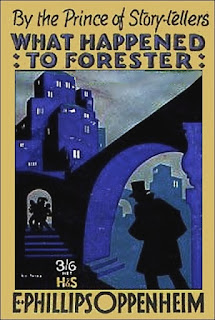This column appeared in the May 24, 1930 issue of the New York Evening Post.
MANHATTAN NIGHT. By William Almon Wolff. Minton, Balch. $2.
THE MAN WHO WAS THERE. By N. A. Temple-Ellis. Dutton. $2.
THE DEATH OF COSMO REVERE. By Christopher Bush. Crime Club.
$2.
WHAT HAPPENED TO FORESTER. By E. Phillips Oppenheim. Little,
Brown. $2.
F-L-A-S-H D.13. By Victor K. Kaledin. Coward-McCann. $2.50.
“THE SCARAB MURDER CASE," latest Philo Vance figment,
revolves around the murder of a philanthropist in a museum in Gramercy Park.
The museum and the house adjoining it are cluttered up with Egyptian spoils,
Egyptians and Egyptologists. Hani, the bearded Copt, says Sakhmet, Egyptian
goddess of vengeance, bashed in the philanthropist's skull; District Attorney
Markham and Sergeant Heath accuse Dr. Mindrum W. C. Bliss, head of the museum;
Philo Vance insists that there are too many clues pointing too obviously at Dr.
Bliss. You can imagine who is proven right by the final outcome. The plot has several
interesting twists, though its ending is not altogether convincing and its
course is slowed up by the irrelevant profundities that Mr. Van Dine's public
is supposed to expect of him. Markham and Heath are as incomparably
inefficient, as amazingly ignorant of even beat-walking police routine, as
ever.
“MANHATTAN NIGHT” is a reasonable mystery story, planned and
committed with due exercise of the author's—and respect for the
reader's—intelligence. Its characters react to murder, mystery and suspicion as
people react, suspense is built up by interesting the reader in what happens
and what may happen to these characters instead of the complicated mechanical
ingenuities. Martha Thayer returns to her penthouse home at three-something one
morning to find her husband, with whom she had quarreled in a speakeasy a few
hours before, dead, shot, and the gun gone. She telephones Peter Wayne
—college-mate of her husband, in love with her—thus, at least in the eyes of Inspector
Connolly, implicating him. Evan Ross, whom she loved and her husband hated,
disappears. There are other targets for the reader's suspicions —Benny, to whom
Martha had paid blackmail-tribute; Dr. Zahn, the psychoanalyst she had
consulted; Rita Gould, Ross's friend; other members of their night-club set.
There is a vague but actual similarity between this book and Rupert Hughes's
"Ladies' Man," but this is by far the better book. Its night-life sections
are nicely done. There is also a very satisfactory detective.
“THE MAN WHO WAS THERE" is a first-rate fable of murder
and other wild doings on the Isle of Wight, with people who are not what they
seem, much deviltry in the dark along the edges of cliffs and in the bungalow,
where the mysterious Mr. Flyte was done in. Montrose Arbuthnot and Sir Edmund King
are the sleuths, stumbling into the mystery via the much-used busman's holiday
route. The latter part of the book is weakened by too much new stuff sprung on
the reader and by the necessity the author is under of turning handsprings to
extricate himself from the excellent tangle he had contrived earlier in the
story
“THE DEATH OF COSMO REVERE" is another involved,
cleverly plotted tale of murder, forgery and other crimes in rural England. The
gentleman whose name is part of the title seems at first to have been killed by
a tree he had felled, but the only yellow sand in the vicinity was on his
forehead. That was enough to set Messrs. Franklin and Travers of Durango House
a-digging for evidences of dirty work. They found plenty. You will probably guess
who killed Cosmo, but you are not likely to find out the how and the why until
the author tells you. The book's weaknesses are several unnecessarily tiresome
stretches where nothing happens, the dullness of the two detectives—it is
almost impossible to tell them apart—and a lack of clarity or vividness in the
telling.
“WHAT HAPPENED TO FORESTER" is composed of ten short
stories or encounters with more or less odd characters and events that an
Oppenheim Englishman of the Monte-Carlo-frequenting sort had. Most of the
stories are rather thin and, in spite of underlying variety, pretty much
alike—facile merchandise for the magazines.
“F-L-A-S-H D.13" purports to be the history of nine
operations that engaged the talents of an assistant chief of the Personal Court
Branch of the Russian Imperial Secret Service. There are pogroms, attempts on
the Czar's life, espionage during the war, the assassination of Rasputin and so
on. It is all very melodramatic, but, in spite of an occasional high spot, too
vague for me to make any guesses at its authenticity. My chief interest in the
book lay in comparing certain of its sentences with certain sentences from my
own opera. For instance, I had written in "The Maltese Falcon":
"Where Bush Street roofed Stockton before slipping downhill to Chinatown .
. . night-fog, thin, clammy and penetrant, blurred the street . . . an
automobile popped out of the tunnel beneath him with a roaring swish. . . . His
clothes had the limp unfreshness of too many hours' consecutive wear." Mr.
Kaledin has written: "where Nijny Avenue Joins Tchechov Street before
slipping down hill to Nevsky Prospect" (page 60); "night fog, thin,
clammy, penetrant, blurring the streets" (page 64); "popped out of
the garage with a roaring swish" (page 59), and "his clothes had the
limp unfreshness of too many consecutive hours of wear" (page 60).
Recommended with reservations given above: "Manhattan
Night," "The Man Who Was There" and "The Death of Cosmo
Revere."






3 comments:
I see there is a copy of MANHATTAN NIGHT. By William Almon Wolff available on ABE, though it has no dust jacket. Seems he liked it better than most.
I can't help wondering what he'd think of our books today.
How embarrassing to get caught by Hammett stealing from Hammett.
Post a Comment